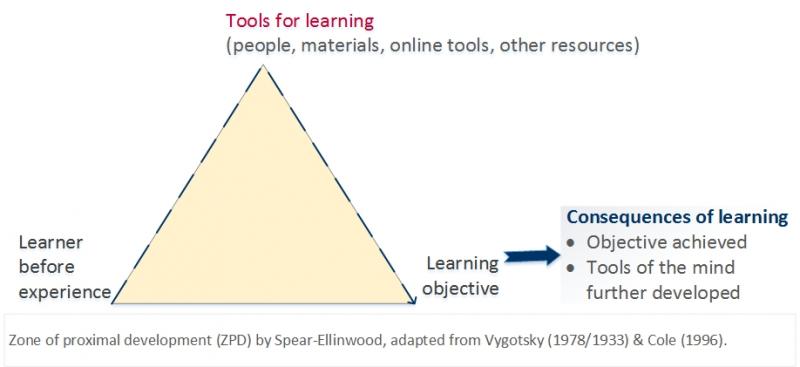The challenge in learning something new always involves a “learning curve” (Slamecka, 1985, on Ebbinghaus, 1885). The learning curve is the process through which we develop mastery of knowledge, skills, and practices over time. The length and depth of that curve is determined by learner and educator abilities, knowledge, practices, and the strategic guidance provided by educators to assist learners in reaching our goals.
Mediating Learning and Development
To mediate that learning curve, educator and learners may create zones of proximal development, that is, learning situations characterized by the distance between what the learner can achieve on their own and the greater challenges they could achieve with the strategic assistance or guidance of the instructor. Zones of proximal development are negotiated, then, through the use of tools - human as well as material resources and practices (Vygotsky, 1978/1933; also Moll, 2013; Cole, 1996; Cole & Engeström, 1993). When students learn they not only achieve specific or concrete learning objectives, they also further develop tools of the mind, that is, metacognitive strategies, problem-solving skills, and other educational strategies and practices that support and mediate future learning (Moll, 2013; Cole, 1996).
Developmental Curriculum
A developmental curriculum, then, is based on this concept of learning and plans for a contimmum of learning experiences through successive zones of proximal development. In a developmental curriculum, the educator's purpose is to create a learning situation that challenges the learner while drawing on their present skills and knowledge, and offering "strategic guidance" (Reiser, 2009) or assistance to enhance these or develop new knowledge or practices, which anticipate ever-increasing challenges over the course of the educational program.
Strategic Guidance
Strategic guidance means that we provide information, resources, tools or other assistance or guidance that builds on the learner's knowledge, skills and practices, and will help them to achieve some proximal goal as well as become part of a tool set for future learning (Cole, 1996; Vygotsky 1978/1933; also Reiser, 2009). When we teach students how to learn or think in specific ways (e.g., case-based instruction, problem-solving, team learning, reflective writing), we are building their toolkit for future learning.
Related Resources


